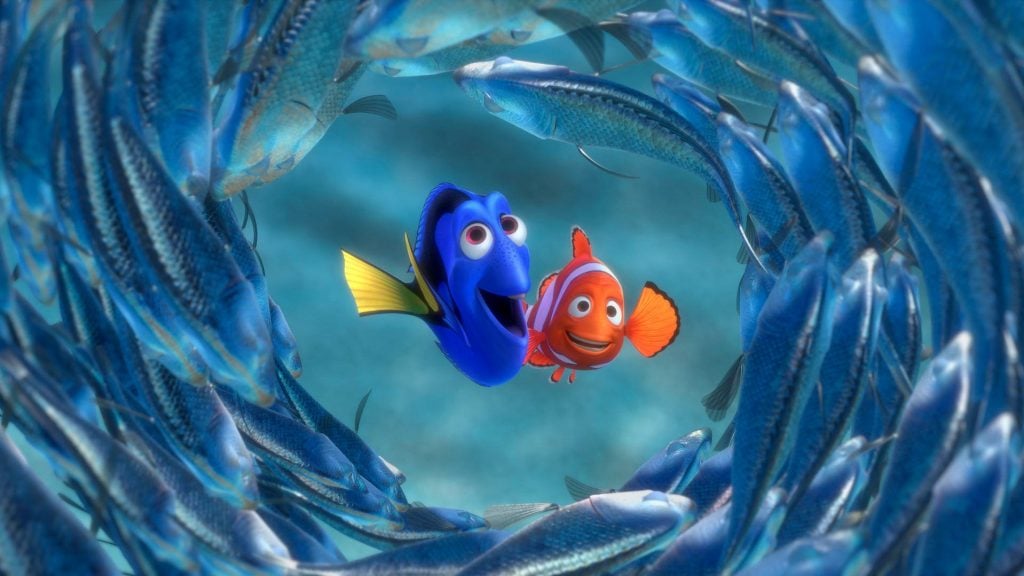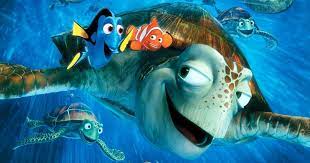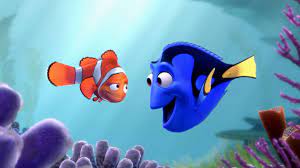🎬 Finding Nemo (2003)

Introduction and Narrative Overview
Finding Nemo, released on May 30, 2003, by Pixar Animation Studios and Walt Disney Pictures, is a landmark animated adventure that dives deep into the ocean and the heart. Directed by Andrew Stanton, with co-direction by Lee Unkrich and a screenplay by Stanton, Bob Peterson, and David Reynolds, the film follows Marlin (voiced by Albert Brooks), a paranoid clownfish, on a desperate quest to find his son Nemo (Alexander Gould) after he’s snatched from their Great Barrier Reef home by a scuba diver. Produced during Pixar’s golden era, it’s a tale of courage, family, and letting go that redefined animated storytelling.
The plot begins with tragedy—Marlin’s wife Coral and most of their eggs devoured by a barracuda—leaving him a neurotic single dad to Nemo. When Nemo, born with a stunted “lucky fin,” defies Marlin’s overprotection and gets netted, Marlin teams with Dory (Ellen DeGeneres), a forgetful blue tang, to chase the diver’s boat to Sydney. Their odyssey spans shark encounters, jellyfish fields, and a turtle highway, while Nemo plots escape from a dentist’s fish tank with a quirky crew led by Gill (Willem Dafoe). The dual narrative converges in a thrilling harbor rescue, blending humor, peril, and Pixar’s signature emotional heft.
Finding Nemo shines with its universal stakes—parental fear versus a child’s need for independence—wrapped in a fishy road trip. Its pacing is near-perfect, balancing slapstick with tear-jerking beats, though the tank subplot occasionally overstays its welcome. Inspired by Stanton’s own parenting struggles, it’s a heartfelt triumph that speaks to kids and adults alike, cementing Pixar’s reputation for stories that swim beneath the surface. Its ocean-spanning scope and tight 100-minute runtime make it a buoyant classic.

Performances and Character Dynamics
The voice cast of Finding Nemo is a treasure trove, with Albert Brooks anchoring as Marlin. His nasally, fretful delivery—peppered with dry wit—captures a father’s love and panic, evolving from smothering to trusting in a performance that’s both hilarious and raw. Ellen DeGeneres’s Dory is the film’s soul, her scatterbrained optimism (“Just keep swimming”) and memory lapses masking a tender depth that steals every scene. Their odd-couple chemistry—Marlin’s grumpiness clashing with Dory’s cheer—drives the journey, a bond forged through chaos that’s pure Pixar magic.
Alexander Gould’s Nemo brings youthful spunk, his defiance and resilience shining in the tank, where Willem Dafoe’s gravelly Gill—a scarred moorish idol—leads with brooding authority. The tank gang—Brad Garrett’s blustery Bloat, Allison Janney’s anxious Peach, Stephen Root’s manic Bubbles—delivers comedic gold, each quirk dialed to perfection. Supporting players like Barry Humphries’s shark Bruce (“Fish are friends, not food”) and Geoffrey Rush’s pelican Nigel add flavor, while John Ratzenberger’s crab cameo keeps Pixar’s streak alive.
Marlin and Nemo’s strained father-son dynamic is the emotional core, their separation amplifying mutual growth—Marlin learning to release, Nemo to prove himself. Dory’s friendship with Marlin, deepened by her own lost-family reveal, adds layers, while the tank crew’s teamwork mirrors the reef’s community. The ensemble’s interplay is seamless, though minor characters like the turtles (led by Stanton’s laid-back Crush) occasionally overshadow quieter beats. It’s a vocal symphony that elevates a simple fish tale into a profound family saga.

Visuals, Action, and Technical Craft
Visually, Finding Nemo is a groundbreaking plunge, its underwater world a marvel of early-2000s CGI. Pixar’s team, led by cinematographers Sharon Calahan and Jeremy Lasky, crafts a reef alive with coral pinks, anemone purples, and ocean blues, every ripple and bubble meticulously rendered. The Sydney harbor’s murky realism contrasts the reef’s vibrancy, while character designs—Marlin’s droopy fins, Dory’s darting eyes—burst with personality. The jellyfish swarm, a pink haze of danger, and the East Australian Current’s surfer-dude turtles showcase animation that was revolutionary, pushing Pixar beyond Toy Story’s toybox.
Action sequences dazzle with purpose. The barracuda opener sets a chilling tone, the shark chase blends terror and laughs, and Nemo’s filter escape thrums with tension. Editors David Ian Salter and Lee Unkrich keep the 100 minutes fluid, pacing adventure with pathos—like Marlin’s despair at Nemo’s “death.” Thomas Newman’s score, a mix of whimsical flutes and swelling strings, buoys the emotion, its “Nemo Egg” theme a tearjerker staple. The sound design—gurgling currents, tank hums—immerses viewers in a subaquatic symphony.
Technical feats abound, from water simulations to fish physics, though some backgrounds now look dated next to 2025’s hyper-real CGI. Still, the film’s artistry—hand-painted textures, practical lighting—holds up, earning its Oscar for Best Animated Feature. It’s a visual poem that captures the ocean’s vastness and intimacy, a testament to Pixar’s craft at its peak.

Themes, Reception, and Franchise Impact
Thematically, Finding Nemo explores parenthood, resilience, and trust. Marlin’s arc—overcoming loss to let Nemo swim free—mirrors real-world struggles, while Nemo’s disability fuels a tale of defiance over limitation. Dory’s memory gaps turn weakness into strength, her mantra a life raft for despair. The ocean’s dangers—sharks, nets—test community, from the tank’s solidarity to the reef’s unseen bonds. It’s a story of facing fear with love, delivered with Pixar’s knack for making kids’ fare profound.
Reception was rapturous, with a 99% Rotten Tomatoes score (8.2/10) and universal acclaim as Pixar’s finest hour. Critics praised its “visual splendor” (Roger Ebert) and “emotional resonance” (Variety), while audiences propelled it to $940 million worldwide—2003’s top animated earner—against a $94 million budget. Its 86% audience score and 4K re-release in 2023 affirm its staying power. By February 28, 2025, it’s a beloved classic, its lines (“Righteous!”) and score evergreen.
For Pixar, it birthed Finding Dory (2016), a $1 billion sequel, and cemented the studio’s emotional-animation dominance. Its legacy spans aquariums (clownfish demand surged) and memes, influencing Zootopia and beyond. As of 2025, it’s a touchstone of the 2000s, a perfect storm of heart and craft that still hooks new generations. It’s not just a film—it’s a tide that keeps flowing.










